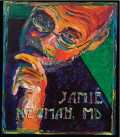Pott-y language
Tuberculosis with spinal involvement is often referred to as Pott's disease.
It was 3:00 a.m., and it was my first night shift on inpatient medicine as a third year. I sat on the edge of my chair in the resident call room, anxiously awaiting the next page from the ED alerting my intern of a new admission. “Beep beep beep!”
This patient was an otherwise healthy young man who had emigrated from Somalia to the U.S. 14 years ago. He was admitted for a 6-week history of dry cough, severe chest and back pain, and shortness of breath. He also described having a flu-like illness with fevers, drenching night sweats, and a 17-pound unintentional weight loss. A chest CT from the referring hospital revealed a massive right-sided pleural effusion, ground-glass infiltrates at bilateral lung apices, spondylosis of his T5-T9 vertebrae with an associated thoracic paraspinal abscess, and multiple splenic lesions suggestive of granulomas. Labs revealed elevated alkaline phosphatase levels with normal bilirubin and aminotransferase levels, hypoalbuminemia, and normal renal function. Urinalysis was abnormal with many dysmorphic red blood cells and proteinuria. Acid-fast sputum stain was positive, and disseminated tuberculosis was diagnosed.

I was on with Dr. Newman, so I knew that I had better be prepared for both a clinical discussion and a historic one.
Tuberculosis with spinal involvement is often referred to as Pott's disease, in honor of the historic 18th-century surgeon Percivall Pott, who first described its clinical presentation in the medical literature. Percivall Pott was born into humble beginnings in London, England, in the early 1700s, suffering the loss of his father at a young age. A wealthy distant relative financed his apprenticeship and tutelage under the surgeon Edward Nourse at St. Bartholomew's Hospital. Dr. Pott aided in the preparation of cadavers for public dissection and studied surgical technique under Dr. Nourse, eventually opening his own surgical practice in 1736. He took a position as an assistant surgeon in 1744 and had become one of the best surgeons of his time when he was appointed to serve as a full surgeon at St. Bartholomew's in 1749.
In 1756, Dr. Pott suffered a compound fracture of his fibula and tibia after being thrown from his horse on his way to work one morning. His surgical colleagues insisted that his leg needed to be amputated, but Dr. Nourse was able to nonsurgically reduce the fracture, which eventually fully healed without any further intervention. Dr. Pott's path to recovery was quite lengthy, and some might argue this was a blessing in disguise, as he penned many hallmark contributions to the medical literature during this period in his life.
“A Treatise on Ruptures,” published in 1756, described the cause and treatment of hernias, and “Observations on the Nature and Consequences of Wounds and Contusions of the Head, Fractures of the Skull, Concussions of the Brain,” published in 1760, covered traumatic skull and brain injuries. In 1765, Dr. Pott discussed what would become the standard methods for treating fractures and dislocations in “Some Few General Remarks on Fractures and Dislocations,” including a description of what we call Pott's fracture, which is a much milder injury than the one he himself suffered.
Perhaps one of Dr. Pott's most seminal contributions was his work on tracing the cause of a type of cancer back to a specific hazardous exposure associated with one's occupation. In 18th-century London, many young boys worked as chimney sweeps, climbing through chimney flues to clean out blocked soot, which was a dangerous and often life-threatening job in itself. However, many of these boys began to develop squamous-cell carcinoma of the scrotum in their teens and 20s due to chronic exposure of the scrotal skin to carcinogenic compounds in coal soot. This was the first time anyone had introduced the public health concept of an occupational cancer.
In “Remarks on the Kind of Palsy of the Lower Limbs, Which Is Frequently Found To Accompany a Curvature of the Spine,” published in 1779, Dr. Pott described the clinical manifestations of extrapulmonary tuberculosis of the spine. He carefully depicted the collapsed vertebrae and resultant curvature of the spine but did not understand how this caused the eventual paralysis and neurologic sequelae.
Pott's disease is a life-threatening condition, even with advances in medical treatment, due to this potential for neurologic compromise. Tuberculosis infection of the spine is the most common manifestation of extrapulmonary tuberculosis, although it occurs in fewer than 1% of overall patients with tuberculosis, according to studies in the March 2001 Neurosurgery Review and the August 1995 Journal of Neurosurgery. Tuberculosis is a serious public health problem in Somalia. In a national 2011 survey published in Emerging Infectious Diseases, multidrug-resistant tuberculosis was found in 5.2% and 40.8% of patients in Somalia with new and previously treated disease, respectively.
Our patient was later found to have additional lesions in his S1 vertebrae, but no further abdominopelvic involvement was found on CT. He was started on the standard treatment regimen for spinal tuberculosis (rifampin, isoniazid, pyrazinamide, and ethambutol), with pending antibiotic sensitivities, and is currently being evaluated by our neurosurgery colleagues to determine the need for a thoraco-lumbar sacral orthosis (TLSO) brace to prevent vertebral collapse secondary to his Pott's disease and potential drainage of his paraspinal abscess.



